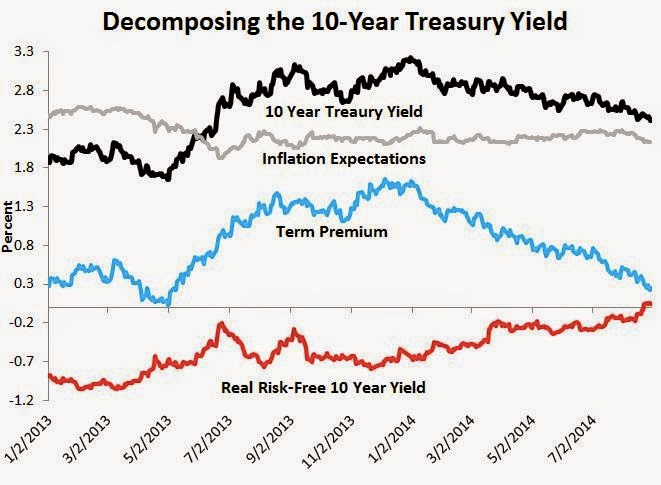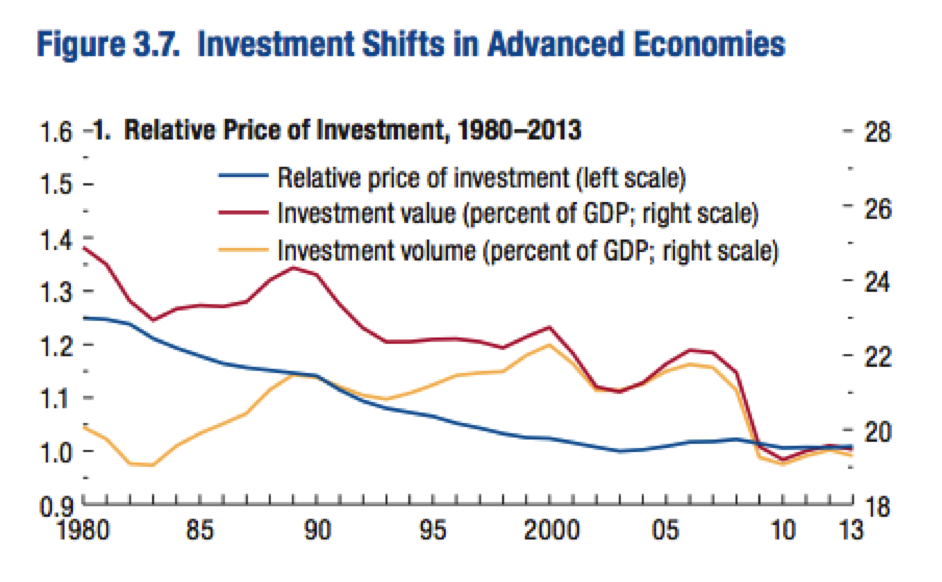On the Relationship Betweem the Market Risk Premium and the RiskFree Interest Rate
Post on: 26 Май, 2015 No Comment

MARKET RISK PREMIUM
AND THE RISK-FREE INTEREST RATE
Confidence W. Amadi confidence.Amadi@famu@edu is an Associate Professor of Finance at Florida A&M University.
This study looks at the relationship between the market risk premium, constructed as the difference between a running annual return on a market portfolio and the monthly yield on proxies for the risk-free rate, and the risk free rate. The stationarity properties of the resulting time series were studied as well as the relationship between the stationary time series. The results suggest that the market risk premium is a level stationary process, whereas the measures of the risk-free rate are first difference stationary. Consequently a bivariate long-run relationship cannot exist between the risk-free rate and the market risk premium. Basic intuition suggests that the magnitude of the risk premium should be related to the magnitude of the risk free rate. The lack of integratedness between the risk premium and the risk free rate has implications on the construction of the equity risk premium used in the determination of the required rate of return. An OLS regression of the risk free rate and the market risk premium exhibits a strong autocorrelation, indicating that the market risk premium is a function of more variables than the risk free rate.
INTRODUCTION
Since the development of the capital asset pricing model, the market risk premium has taken central stage in the determination of the cost of equity capital. The cost of equity is a key variable in the capital budgeting decision process. Errors in its estimation can lead to the acceptance (rejection) of unprofitable (profitable) profits. It is also an essential input in the determination of management’s performance based compensation where its impact is evidenced in the calculation of the firm’s EVA. (EVA is a registered trademark.) In addition, the cost of equity is used extensively by public utility commissions to set the rate of return utility companies may earn on their invested capital. This rate has a direct impact on the price these firms can charge their customers. Despite the importance of the cost of equity in the economy, there is little agreement on the appropriate value of the market risk premium.
Previous studies on the magnitude of the market risk premium have tended to focus on the historical average difference between some proxy for the market portfolio and the yield on the Treasury bill. The size of the risk premium has exhibited a strong dependency on the time interval over which the return was based. Jagannathan, McGrattan and Scherbina (2001) finds that the US equity premium averaged 8.9 percent during the fifties and 3.98 percent in the nineties. Siegel (1992), based on the arithmetic mean of the short-term risk-free rate and the real return on equity, reported an equity risk premium of 1.99 percent and 6.92 percent for the periods 1800-1888 and 1889-1978, respectively. For the period 1928-1998, Siegel (1998,1999) report an equity risk premium over the Treasury bill of 8.6 percent. Dimson, Marsh, and Staunton (2002) computed the equity risk premium for 92 overlapping decades across 16 countries of 5.1 percent.
Arnott and Bernstein (2002), argue that basing the magnitude of the equity risk premium on historical realized return is misleading because the “ the market exceeded objective expectations as a consequence of a series of historical accidents”. These accidents they list as follows: 1) decoupling of yields from real yields, 2) rising of valuation multiples, 3) survivor bias, and 4) regulatory reforms. They argue that the historical return as measured by the market index ignores the fact that “An important engine for economic growth is the creation of new enterprises. The investor in today’s enterprises does not own tomorrow’s new enterprises- not without making a separate investment in those new enterprises with new investment capital”. They demonstrate that “the historical average equity risk premium, measured relative to 10-year government bonds as the risk premium investors might objectively have expected on their equity investments, is about 2.4 percent”.
By modeling the theoretical link between unrecorded accounting goodwill, accounting profitability and the cost of equity, together with the Capital Asset pricing Model betas, O’Hanlon and Steele (2000) were able to estimate the ex ante risk premium for the United Kingdom. Their results suggest that for the period 1968-1995, the equity risk premium was in the region of 5 percent, a number that is significantly lower than the average realized equity risk premium. Tippet (2000) contends that the methods reported in O’Hanlon and Steele (2000) cannot return a reliable estimate of the equity risk premium because of their “use of numerical methods to derive measures which proxy for some true but unknown variables, the estimation of betas using an inefficient index portfolio and the likelihood that the structural model on which their analysis is founded is seriously mis-specified”.
Instead of using historical data, Blanchard (1993) and Wadhwani (1999), apply a forward-looking version of the constant-growth dividend model to estimate the implied equity risk premium. Blanchard (1993) concludes that the equity risk premium declined steadily during the early 1950s, with a transitory increase in the 1970s, to a premium around 2-3 percent. Wadhwani (1999) concludes that in order to justify the index level of 1150 for the S&P 500, given a dividend yield of 1.65 percent and a long-term growth rate of 1.9 percent for the period 1926-1997, the implied equity risk premium had to be negative (-0.15 percent). These studies all seem to emphasize the uncertainty in the size of the equity risk premium. They also have the implicit assumption that the equity risk premium is independent of the level of the risk free interest rate. In contrast, Kairys (1993) presents and tests three different models that use ex ante commercial paper rates to forecast the equity risk premium. They conclude that a negative equity risk premium can be predicted using information in commercial paper rates.
The variability in the equity risk premium can be attributed to changes in the investors’ attitude towards risk, changes in the risk free rate, or a combination of both factors. The objective of this paper is to explore the relationship between the equity risk premium and the risk free rate.
DATA AND METHODOLOGY
The data for this study is obtained from Global Financial Database and the CRISP Database. The constant maturity yields on the ninety-day T-Bill and one-year and ten-year T-Notes (obtained from the Global Financial Database) are used as proxy for the risk-free interest rate. The total return on the S&P 500 index and the NYSE index (obtained from the CRISP database) are used as proxies for the market portfolio. The study period is from January 1930:01 to December 2002:12. The monthly returns on the market portfolio are converted into successive rolling twelve month returns to generate the realized annual returns for the equivalent annual yields on the Treasuries. The variables are defined as follows:
TenYear: Yield on the ten-year Treasury note
OneYear: Yield on the one-year Treasury note
ThreeMonth: Yield on the three-month Treasury bill
NYSETen: Market Risk Premium using the NYSE index and Ten-year Treasury note
NYSEOne: Market Risk Premium using the NYSE index and One-year Treasury note
NYSEThree: Market Risk premium using the NYSE index and Three-month Treasury bill

SPTen: Market risk premium using the S&P 500 index and Ten-year Treasury note
SPOne: Market risk premium using the S&P 500 index and One-year Treasury note
SPThree: Market risk premium using the S&P 500 index and Three-month Treasury bill
Establishing the long-run relationship between a pair of time series requires that the variables be cointegrated. If a series must be differenced d times before it becomes stationary, it is said to contain d unit roots and integrated of order d. expressed as I(d). For two series yt and xt to be cointergrated, they each must be integrated of the same order d. Moreover, there must exist a vector , such that the error term from the regression (t =yt – xt ) is of a lower order of integration, I(d-b), where b>0. According to Engle and Granger (1987), the two series are said to be cointegrated of order (d, b). Cointegration implies that even though the two or more series themselves may contain stochastic trends, the series are linked to form an equilibrium relationship to which the system converges over time. The error term, t . can be interpreted as the distance that the system is away from equilibrium at time t.
In order to investigate the long-run relationship between market risk premium and the risk-free rate, it is necessary to determine the integration of these variables. To achieve this, the augmented Dickey-Fuller (ADF) test of Said and Dickey (1984) and Said (1991) is employed. The test is based on the null hypothesis of unit root with drift process against the alternate of trend stationary process. The selection of the optimal lag length is based on the Akaike Information criterion (AC), multivariate Hannan-Quinn (1979) criterion (HQ), and multivariate Schwarz (1978) Bayesian (SC) criterion.
Given the integration characteristics of the market risk premium and risk-free rate variables, the Johansen maximum likelihood procedure is used to test for possible cointegration between the variables. Johansen (1988; 1991) and Johansen and Juselius (1990) procedure is based on the error-correction representation of the vector autoregression VAR(k ) model with Gaussian errors. Johansen and Juselius (1990) likelihood-ratio tests (Lambda-max and Trace tests) are used to determine the number of cointegrating vectors based on the maximum likelihood estimates of the cointegrating vectors. The lag length, k. is chosen by a combination of AC, HQ, and SC criteria.
Granger (1986, 1988) pointed out that if two variables are cointegrated, then Granger causality must exist in at least one direction. Granger (1969) describes a variable xt as Granger causing another variable yt. if the inclusion of lagged values of x improves the forecast of y. Engle and Granger (1987) point out that the standard Granger causality tests are inappropriate and misleading in the presence of cointegration. Standard Granger causality tests that are augmented with error-correction terms, obtained from the cointegrating relationship, are used to investigate the long-run effects. According to Engle and Granger (1987), such tests assure that valid inferences can be made on variables that are cointegrated.
STATIONARITY TEST RESULTS
The augmented Dickey-Fuller (ADF) test was conducted using the following regression model:
zt = 0 + zt-1 + T +














